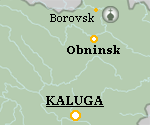 | ||
The Cathedral of the Nativity of the VirginThe cathedral with Dionisy’s frescoes has not survived. In 1586, on its site a new five-domed cathedral was built  Kaluga areaThe monastery is located in Kaluga area near the town of Borovsk Search | ||
 |
|
The St. Paphnutius Borovsk (Pafnutiev-Borovsky) Monastery. The Cathedral of the Nativity of the Virgin. Between 1467 and 1476
 A view of the St. Paphnutius Borovsk Monastery |
The St.Paphnutius Borovsk Monastery was founded by St. Paphnutius of Borovsk in 1444 on a beautiful high bank where the Istrema River flows into the Protva River. Here St. Paphnutius passed away on 1 May 1477 at the age of 82. Upon his death, St. Joseph Volotsky became the hegumen of the monastery. Shortly after he introduced a strict monastic charter, which was rejected by the monks, he had to leave. He went to the principality of Volokolamsk, where founded a new cloister, later named the St. Joseph Volokolamsk Monastery.
The frescoes of the Cathedral of the Nativity of the Virgin in the St. Paphnutius Borovsk Monastery are the earliest known work by Dionisy. From St. Paphnutius’ biography we learn that Dionisy under a supervision of icon painter Mitrophan, an elder (starets) of the Simonov Monastery, painted the stone cathedral of the Nativity of the Virgin of the St. Paphnutius Borovsk Monastery.
The cathedral was built of a white stone on the site of an old wooden church and was consecrated in 1467. The exact date of the frescoes is not known. Yet, it is certain that it was made when St. Paphnutius of Borovsk was still alive.
117 years later, in 1586, the cathedral was taken to pieces and by the decree of Fyodor Ioanovich a new five-domed cathedral was erected on the site. Blocks with the 15th century frescoes were used for its foundation and backup.
Nevertheless, Dionisy’s frescoes in the Virgin Nativity Cathedral of the St. Paphnutius Borovsk Monastery did not survive the cathedral’s reconstruction.
 Head of an unknown saint. Dionisy |
The icon St. Simeon, the God-Receiver originates from the St.Paphnutius Monastery. The image of St. Simeon, who, according to the New Testament, received Jesus Christ in his hands, resembles St. Paphnutius in the way he is represented in the sacred biography.
In the sixteenth century, the monastery was encircled with stone walls and fortifications and turned into a strong frontier fort. The construction of a stone refectory with a cathedral of the Nativity of Jesus Christ dates back to those times. In 1523, a belfry was built but was replaced in 1688 with a bell-tower that followed the model of the High Petrovsky Monastery Bell-tower in Moscow as commissioned by Duke K.O. Tscherbakov.
The walls and towers of the St. Paphnutius Borovsk Monastery date from the 16th and 17th centuries. There is good reason to believe that the noted architect Fyodor Kon headed the construction of the Povarennaya, Oruzheynaya and Georgievskaya Towers.
 Medallion on a shroud at the bottom of the decoration. Dionisy |
During the Time of Troubles, in 1610, the monastery was burned down by the Poles and “12 thousand people without any rank were killed”. When the Time of Troubles was over, representatives of the St. Paphnutius Monastery took part in the 1613 National Assembly (Zemskiy Sobor) that proclaimed Mikhail Romanov tsar, the certificate of which was signed by the archimandrite Iona from the St. Paphnutius Monastery among others.
Under Catherine II all monastery estates were seized and only 33 monks and novices were left in the St. Paphnutius Monastery. In 1812, the monastery was burned down by the French army but was soon restored.
In 1925, all the property of the cloister passed to the Central museum, but soon afterwards it was turned into a work camp and later into an agricultural school.
During the 1960s restoration works 194 white-stone blocks were extracted; 29 of them have retained fragments of compositions and ornaments painted by Dionisy.
All the fresco fragments are stored in the Rublev Central Museum of Early Russian Art in Moscow and the Borovsk branch of the Kaluga regional museum.
The monastery was returned to the Orthodox Church and opened anew in March 1991. The relics of the founder of the cloister St. Paphnutius of Borovsk rest in the cathedral.
Experts know of around ten cathedrals whose walls were painted by Dionisy. Some of the painter’s works are lost for good; some have been preserved by restorers
Only the wall painting of the Virgin Nativity Cathedral of the St. Ferapont Belozero Monastery has survived in full and intact |
|
According to historical documents, the following works of Dionisy (the dates indicate the year of their painting) are known:
 Plan showing the location of fragments of masonry of the Cathedral of the Virgin Nativity of the St. Paphnutius Borovsk Monastery |
See also: |
|
|
 |
SUPPORTING WITH:
| |||||||||||||








